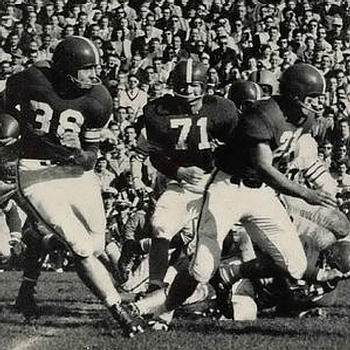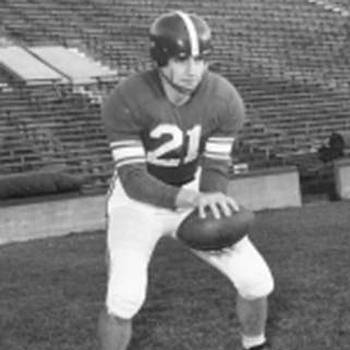

EARL MORRALL, BETTER THAN YOU THINK HE WAS
HELMET HUT NEWS/REFLECTIONS June 2014:
EARL MORRALL, BETTER THAN YOU THINK HE WAS
By Dr. Ken
My introduction to college and professional football was an immediate passion. In truth, playing football, preparing to play football, reading about football, and knowing what could be known brought a great deal of structure and peace to what was otherwise described by teachers, K through 12, as “that kid’s hyper behavior.” For me, football was “the deal,” the one source that could take my entire attention and rivet it upon the names, heights, weights, colleges attended, and the game related statistics. I often think it’s unfortunate that I did not truly begin the mental and emotional “full court press” with college football until 1956 and the NFL until ’58. One may think, “My gosh, you were only eight or nine when you got started, how young did you want to be before you knew the life story of Eddie Price, Lou Michaels, or Jerry Tubbs?” I always had the thought that if I could have been older or felt the tug of football even earlier, there were many more players I would have had a deeper appreciation for. Of course, Earl Morrall was one of these, and this would be the time to interject that few gave Morrall the appreciation he deserved.
 |
 |
Earl Morrall at Muskegon High School
Completing his collegiate career at Michigan State in 1955, I missed out on following Morrall and like most fans, I later thought of him as “one of those Lions back-ups from Michigan State.” At least in 1960 and 1961 it wasn’t unusual for me to confuse Morrall and Jim Ninowski while watching a Lions game on television. I believe that most fans remember Morrall now as a very good back-up quarterback who personally lost Super Bowl III to the New York Jets. The more astute fan will also recall that he saved the Miami Dolphins undefeated season of 1972, but he was much more than this and in my opinion, remains under appreciated for the true talent he was and the influence he brought to every squad he played with. “Every squad” includes his Muskegon, Michigan High School teams of 1950 and ’51, with the latter winning the State Championship behind Morrall’s High School All American season. He also led the Big Reds basketball team to the Regional Championships and the baseball squad to the State Championships. At Michigan State, [ see HELMET HUT http://www.helmethut.com/College/MichState/MIXMSU4755A.html ] he was a Consensus All American quarterback as a senior in 1955,second in the nation in punting, and led the Spartans to a 9-1 mark, a Rose Bowl victory over UCLA, the National Championship, and he finished fourth in the Heisman Trophy balloting. He played the infield well enough on the MSU baseball team, one that went to the College World Series, to consider a number of Major League offers.
 |
 |
|
|
Morrall entered the National Football League as the first round draft pick of the Forty Niners for the ’56 season. Frankie Albert was the new Niners’ head coach and though Morrall played in every game, he was the definite back-up to older hand Y.A. Tittle. With the Steelers dying a slow death in Pittsburgh, they traded for Morrall prior to the 1957 season and as a first time pro starter, he led the moribund team to a 6 – 8 record, completed close to fifty percent of his 289 passes, and played in the Pro Bowl. With Buddy Parker abruptly leaving the Lions and signing on as the new Steelers head coach who desperately wanted his old quarterback Bobby Layne with him, Morrall found himself in a Lions helmet after the Steelers first two games of the 1958 season. Wearing his third team jersey in three years may have beaten the spirit out of many, but Morrall played tough and remained with the Lions until the end of the 1964 season, sometimes starting, sometimes coming in as the relief man, and at times, doing no more than remaining on the bench as a back up to Tobin Rote, Ninowski, and later, Milt Plum.